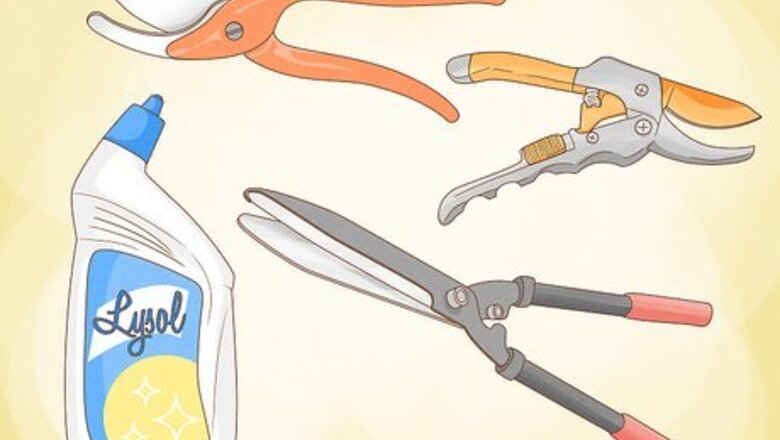
views
How to Prune an Avocado Tree
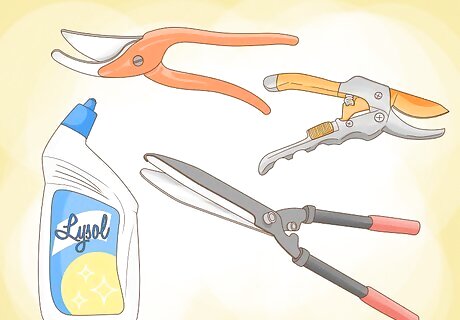
Gather and disinfect your pruning tools before you begin. To prune an avocado tree, you’ll need hand pruners, loppers, protective clothing like gloves and a sunhat, and depending on the size of your tree, a ladder. Pruning tools like pruners and loppers can carry insects, fungus, and bacteria between trees, so spray them with a disinfectant like Lysol or rubbing alcohol before pruning. If you’re pruning multiple trees, be sure to disinfect your tools between each tree. Use hand pruners for branches less than 1 inch (2.5 cm) in diameter. These tools are small and are perfect for removing smaller branches in the tree’s canopy to let the sun shine through. Avocado hand pruners have rounded tips to prevent damaging the fruit. Choose loppers to cut any branches thicker than 1 inch (2.5 cm). Loppers are perfect for removing large branches, particularly at the base of the tree. These tools often go dull easily, so sharpen your loppers before you start pruning. Wear comfortable clothes you don’t mind getting dirty, and choose a wide-brimmed hat to keep the sun off your face and neck. Use a tall, secure ladder with a firm base, and have someone hold it while you work if you need the extra stabilization. A ladder is especially essential for pruning newly planted trees, which have shallow root systems that can’t balance out accelerated growth at the top of the tree.
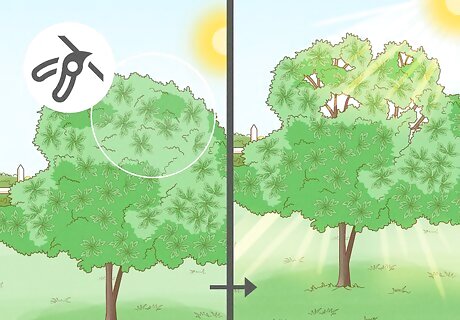
Thin out the canopy so the bottom branches receive enough sunlight. Avocado trees tend to have thick, lush canopies of leaves, which sometimes cause the bottom branches to wilt in shade. Create little “windows” in the canopy by pruning back a few of the topmost branches. Be careful not to create too many open areas in the canopy, though, as this could expose the tree’s major branches to heavy sunlight. A conical or pyramidal tree shape is best for even sun exposure.
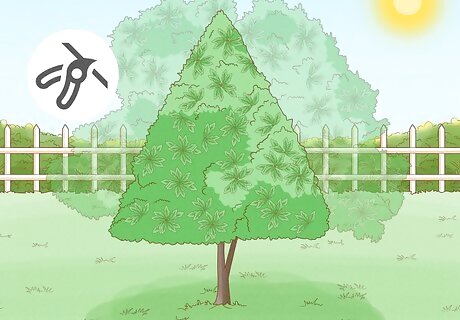
Re-shape the sides of the tree if it becomes too wide. Re-shaping is essential if the tree's branches start tangling with another's, or if the branches are blocking you from irrigating and mowing the area. Use loppers to cut away wild side branches if the tree’s growth gets out of hand. Focus on pruning smaller branches on each side and only prune 1 major branch per year. Make any major cuts clean and keep them in line with the natural contour of the trunk. Re-shaping will likely make fruit yield drop drastically that year, but it should stimulate fruit growth in 2 years. Remember to be extremely careful with this kind of heavy pruning! If you prune too much, you can permanently stunt the tree’s fruit growth.
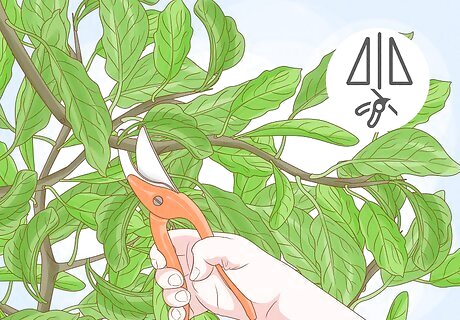
Aim for balance and symmetry when you’re pruning. Keep track of how many branches you remove from each side and mirror your cuts on the other side of the tree as well. It’s important to prune the sides of the tree symmetrically, making identical cuts to either side, to balance the tree’s weight. For example, if you prune several branches on one side of the tree, it may stunt fruit growth on that side. When the fruit grows, the tree’s weight will be unevenly balanced and make it more susceptible to strong wind and harsh weather.
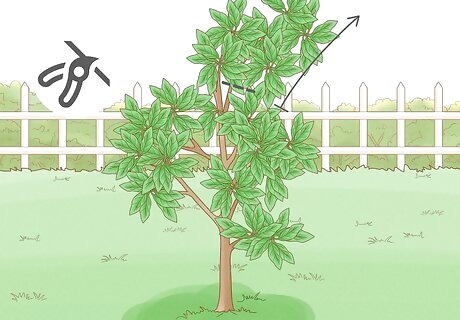
Remove branches at the top of the tree to control its height. Use your loppers to trim back the top slowly, removing only 1 major branch per summer, starting with the tallest. This is especially important for newly planted trees, which don’t have a strong enough root system to support extra height. Be extra vigilant with trees purchased from nurseries, which will likely have a good deal of the roots removed. This process may take 3-4 years to complete, but the slow and steady approach will help reduce stress on the tree.
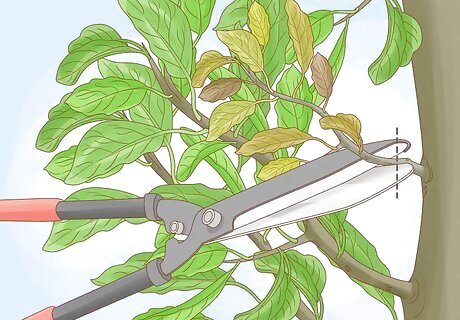
Cut away any dead branches at their base. Use your pruners or loppers to cut away dead branches just above their connection to the trunk, or the branch collar. This will direct the tree's nutrients to the healthy limbs and promote new growth. Although it may be tempting to cut away dead wood at any time of the year, remember that frost damage can sometimes make a branch look dead. Wait for the new growth to begin in spring or summer before determining whether or not the branch needs to be pruned.
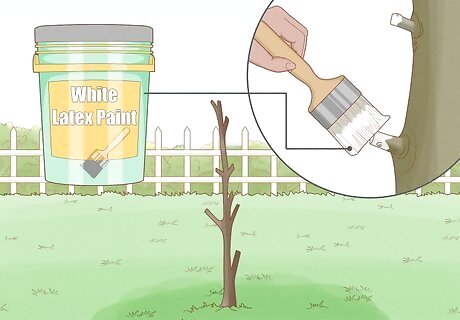
Cut the tree back to its main trunk if it needs rejuvenation pruning. This is an extreme, risky form of pruning, usually used in orchards to promote new growth in later years. Use your loppers to cut all of the branches back to the main trunk, clipping them at the raised ring, or the branch collar, at their base. Avocado trees usually take 3 years to grow and produce fruit again after rejuvenation pruning. Since this type of pruning can permanently damage or kill your tree, it is not recommended for beginners. Unless you have experience with avocado trees, have your rejuvenation pruning done by a professional service.
How to Do Preventative Pruning
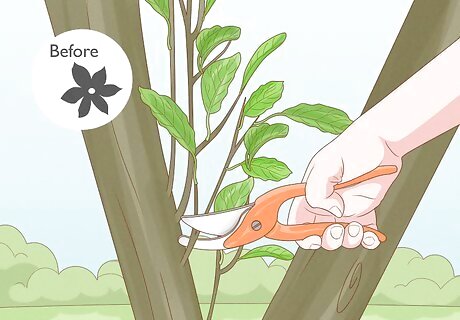
Remove water shoots to prevent imbalances. Before the tree flowers in the spring, use your hand pruners to trim away any water shoots at their base. These vigorous, leafy shoots grow vertically in the bark, and pruning them helps keep the tree’s growth lateral and controlled, rather than wild and untamed.
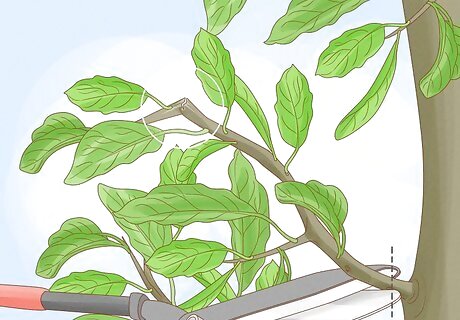
Fix small limb breakages by cutting away the branch at its base. If your branches have been broken by the weight of their fruit or a strong wind, remove them completely. Use your loppers or hand pruners to cut away any small broken branches at their base. This will help redirect nutrients to the rest of the tree and encourage branch regrowth
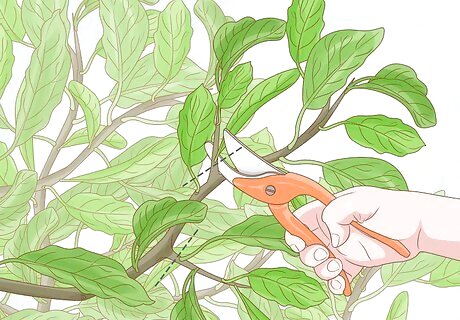
Control wild growth by using thinning cuts. In any areas of the tree that tend to grow quickly and get out of hand, prune smaller branches back to their main subtending branches. These “thinning cuts” will help keep the tree’s growth in check and prevent wild growth in the future.
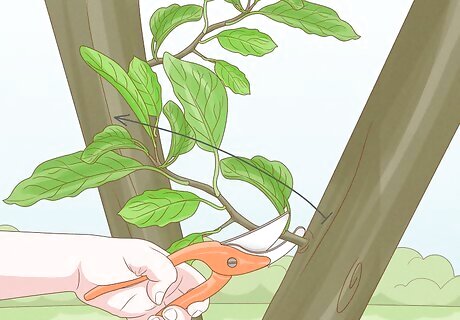
Nip minor issues in the bud so they don’t become major problems. If you spot any wild branches starting to form, such as at the top or low to the ground on the sides, it’s much easier to cut them with loppers or pruners while they’re still small. Waiting until they’ve grown will make the pruning process more difficult and can potentially cause the tree more stress. For example, watch for horizontal branches forming close to the ground. These branches will grow to block your access at the base of the tree, so cut these back at their base as soon as possible.
When to Prune an Avocado Tree
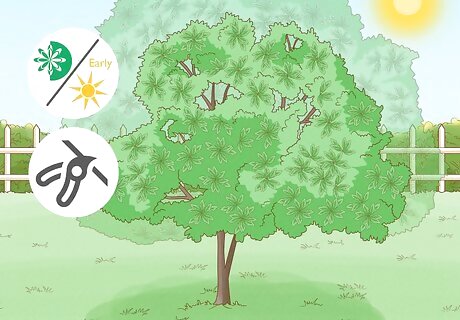
Prune heavily only during spring or early summer to prevent shock. Cutting back during fall or winter weather could expose the avocado tree to cold temperatures and frost, so it’s important to prune in warmer temperatures. The optimum times are the first few weeks of spring or summer. To promote overall regrowth, prune back branches in the spring. Summertime pruning promotes regrowth length and makes the tree grow wider and taller.
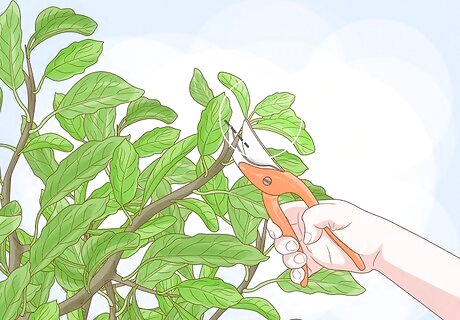
Use preventive pruning year-round to reduce the need for major pruning. Use your hand pruners to cut away any growing tips in areas where you don’t want new branches. Since heavy pruning tends to lower the fruit yield and make the tree just grow back faster, frequent thinning cuts are a much better way to keep the avocado tree’s growth in check. Perform light, preventative pruning any time of the year.
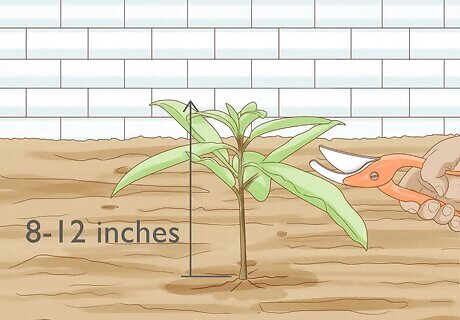
Begin pruning avocado trees as saplings. If you’re growing an avocado tree from seed, it’s best to start pruning when it’s young. When you prune a tree, it focuses its energy on creating new growth, which allows its trunk to thicken and grow more branches. If you don’t prune your tree, it will likely grow flimsy and tall with fewer leaves. To prune a sapling, wait until it’s about 8-12 inches (20-30 cm) tall. Locate a node (the area where a leaf grows) and cut just above it. This ensures a trunk will grow out of the node.
Caring for Your Tree After Pruning
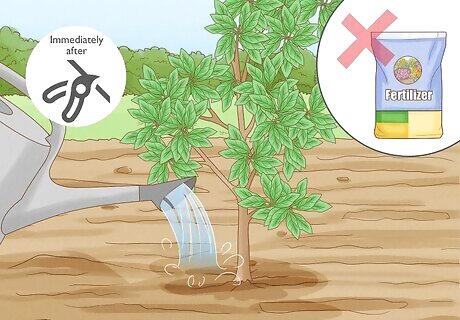
Water the tree immediately, but don’t fertilize. Watering your avocado tree after pruning helps reduce stress and encourage recovery. Avoid fertilizing, however, as this could encourage growth before the tree heals properly. Heavy pruning naturally triggers more foliage, and adding fertilizer could lead to dangerously high amounts of leaf growth.
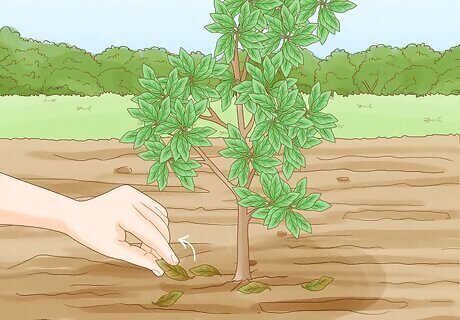
Clean up your clippings. After you’ve pruned your avocado tree, don’t leave your clippings lying around it. This could lead to root rot and other fungal diseases, especially if you removed diseased branches. Rake up the debris and dispose of it properly to ensure your tree stays healthy.
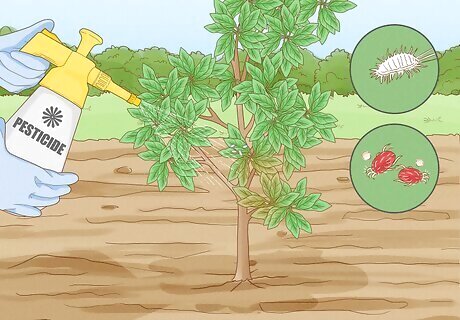
Watch out for signs of disease or infestations. Pests like spider mites, fungus gnats, fruit flies, and mealybugs are often attracted to avocado trees and can damage them. Look for yellowed foliage, curling leaves, and fruit shedding. Perform the appropriate form of pest control as needed.
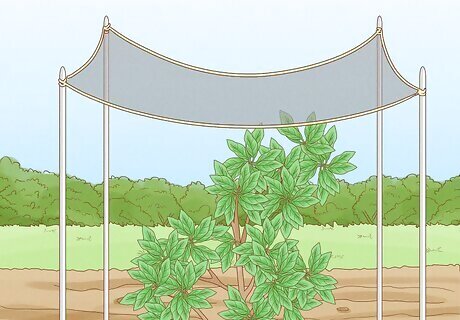
Provide shade for newly pruned trees. If you live in a particularly hot climate, your avocado tree’s branches and leaves can get sunburned. To prevent this, cover newly pruned trees with a shade cloth or make sure these areas are partially covered by foliage from other plants.

















Comments
0 comment